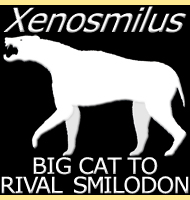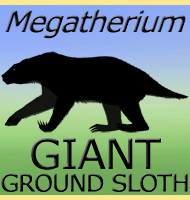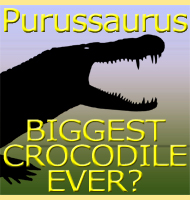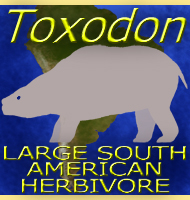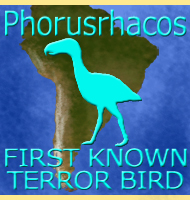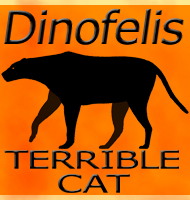


Thylacosmilus
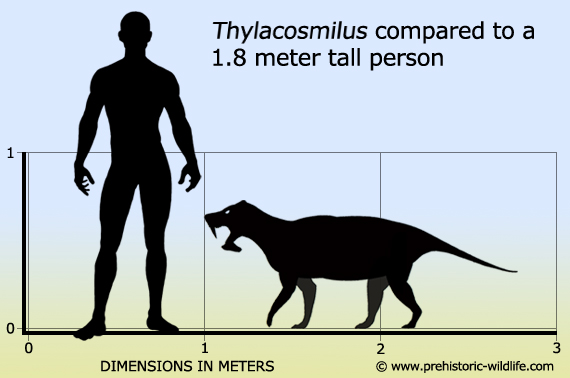
Name:
Thylacosmilus
(Pouch sabre).
Phonetic: Fy-lac-o-smy-luss.
Named By: Elmer S. Riggs - 1933.
Classification: Chordata, Mammalia,
Sparassodonta, Thylacosmilidae.
Species: T. atrox (type),
T.
lentis.
Diet: Carnivore.
Size: 1.2 meters long.
Known locations: South America, Especially
Argentina.
Time period: Late Miocene to early Pliocene.
Fossil representation: Several remains, although a
complete specimen still proves elusive.
With
its oversized front teeth Thylacosmilus appears to
be very similar to
sabre toothed cats like Smilodon.
The key difference between these
two types of animal is that the sabre toothed cats were placental
mammals, which means that young developed while connected to a
placenta via an umbilical cord while remaining inside the mother’s
body. Marsupials like Thylacosmilus however have
a pouch which young
(called neonates) are birthed into at an early stage of development
where they remain until they are ready to be upwardly mobile
themselves. This means that while it looked similar to a sabre
toothed cat, Thylacosmilus was in the same group
as modern kangaroos
and the extinct Thylacine (better known as the
Tasmanian Tiger).
The
most striking feature of Thylacosmilus are the
teeth, even though
they actually only share superficial similarity to those of the sabre
toothed cats. One key difference is that the teeth constantly grew
throughout the life of Thylacosmilus, meaning
that if they were not
worn down they would keep on growing larger. Teeth may have been worn
down by wear form contact with the bones of prey. The mandible also
had two large bone growths referred to as flanges that ran alongside
both teeth so they had extra support and protection when the jaw was
closed. The jaws could also open to a very wide angle, something
that would allow the large teeth to be used efficiently. The price of
this wide opening is that Thylacosmilus would have
had a reduced bite
force. However, this is not a drawback for a predator that relies
upon driving through the points of just two teeth to kill its prey,
as focusing the force upon just two points would have increased the
impact pressure meaning that strong jaw muscles would not have been
necessary for an effective bite.
Thylacosmilus
may have used the oversized teeth in a similar fashion to the better
known sabre toothed cats. This could see Thylacosmilus
ambushing prey
by either staying low in the vegetation or leaping onto it from above.
During these surprise attacks Thylacosmilus could
inflict a deep bite
to a vulnerable area like the neck, something that could sever
arteries that resulted in rapid blood loss. In this Thylacosmilus
is
usually depicted as a lone hunter, although multiple Thylacosmilus
hunting together is not an outright impossibility. Mothers would have
hunted with offspring still inside their pouch and may have even been
joined by them for a period of time when the young were approaching
adulthood.
Ultimately
it may have been contact with the anatomically similar Smilodon
that
brought about the downfall of Thylacosmilus. This
contact was a
product of the Great American Interchange, an event triggered by the
joining of North and South America which allowed animals that were once
isolated from one another to intermix and spread into new areas.
Smilodon was larger and more powerful than Thylacosmilus,
and
probably had a near identical killing technique and prey preference.
When two predators of the same prey animals are in competition to one
another it is usually the weaker and less well adapted of the two that
disappears.
Climate
change is another strong factor as the overall climate where
Thylacosmilus is most well-known was starting to
become drier as
Thylacosmilus began to decline and disappear.
While climate usually
has little direct impact upon predators, it does have a bigger effect
upon prey. The changing types of prey available (as well as
increased competition from new predators) may have meant that
Thylacosmilus was no longer the efficient killer
that it had been in
the past. The attrition of living in a world that was becoming harder
to live in could have ultimately brought the downfall and extinction of
Thylacosmilus.
It
is worth remembering that while Thylacosmilus was
certainly a
formidable hunter, the top predators of South America during the
existence of the genus would have actually been large phorusrhacids,
more popularly known as ‘terror birds’.
Further reading
- Preliminary description of a new marsupial sabertooth from the
Pliocene of Argentina. - Geological Series of Field Museum of Natural
History. 6: 61–66. - Elmer S. Riggs - 1933.
- A New Marsupial Saber-Tooth from the Pliocene of Argentina and Its
Relationships to Other South American Predacious Marsupials. -
Transactions of the American Philosophical Society. 24 (1): 1–32. -
Elmer S. Riggs - 1934.
- Evolution of the Thylacosmilidae, extinct saber- tooth marsupials of
South America. - PaleoBios, 23, 1–30. - L. G. Marshall - 1976.
- Restoration of masticatory musculature of Thylacosmilus, by W. D.
Turnbull. In Athlon, Essays in Palaeontology in Honour of Loris Shano
Russell. Toronto: Royal Ontario Museum. pp. 169–185., C. S. Churcher
(ed.). - 1976.
- Another look at dental specialization in the extinct saber-toothed
marsupial, Thylacosmilus, compared with its
placental counterparts, by
W. D. Turnbull. - In, Development, function and evolution of teeth.
Academic Press. pp. 399–414. Percy, Butler, Joysey Milton &
Alan Kenneth (eds.). - 1978.
- The ear region of the marsupial sabertooth, Thylacosmilus:
Influence
of the sabertooth lifestyle upon it, and convergence with placental
sabertooths. - Journal of Morphology. 181 (3): 239–270. - William D.
Turnbull & Walter Segall - 1984.
- The brain of Thylacosmilus atrox. Extinct South
American saber-tooth
carnivore marsupial. - Journal f�r Hirnforschung. 29 (5): 573–586. - J.
C. Quiroga & M. T. Dozo - 1988.
- Functional-adaptive features and palaeobiologic implications of the
postcranial skeleton of the late Miocene sabretooth borhyaenoid
Thylacosmilus atrox (Metatheria). - Alcheringa: An
Australasian Journal
of Palaeontology. 28 (1): 229–266. - Christine Argot - 2004.
- Comparative Biomechanical Modeling of Metatherian and Placental
Saber-Tooths: A Different Kind of Bite for an Extreme Pouched Predator.
- PLOS ONE. 8 (6): e66888. - S. Wroe, U. Chamoli, W. C. H. Parr, P.
Clausen & R. Ridgely - 2013.
- An eye for a tooth: Thylacosmilus was not a
marsupial 'saber-tooth
predator'. - PeerJ. 8: e9346. - Christine M. Janis, Borja Figueirido,
Larisa DeSantis & Stephan Lautenschlager - 2020.
- The Great American Biotic Interchange revisited: a new perspective
from the stable isotope record of Argentine Pampas fossil mammals. -
Scientific Reports. 10 (1): 1608. - Laura Domingo, Rodrigo L.
Tomassini, Claudia I. Montalvo, D�nae Sanz-P�rez & Mar�a Teresa
Alberdi - 2020.
----------------------------------------------------------------------------
Random favourites
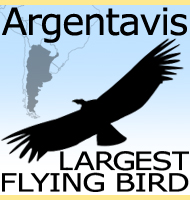 |
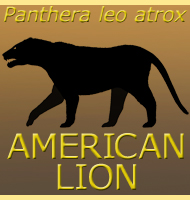 |
 |
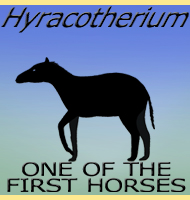 |
